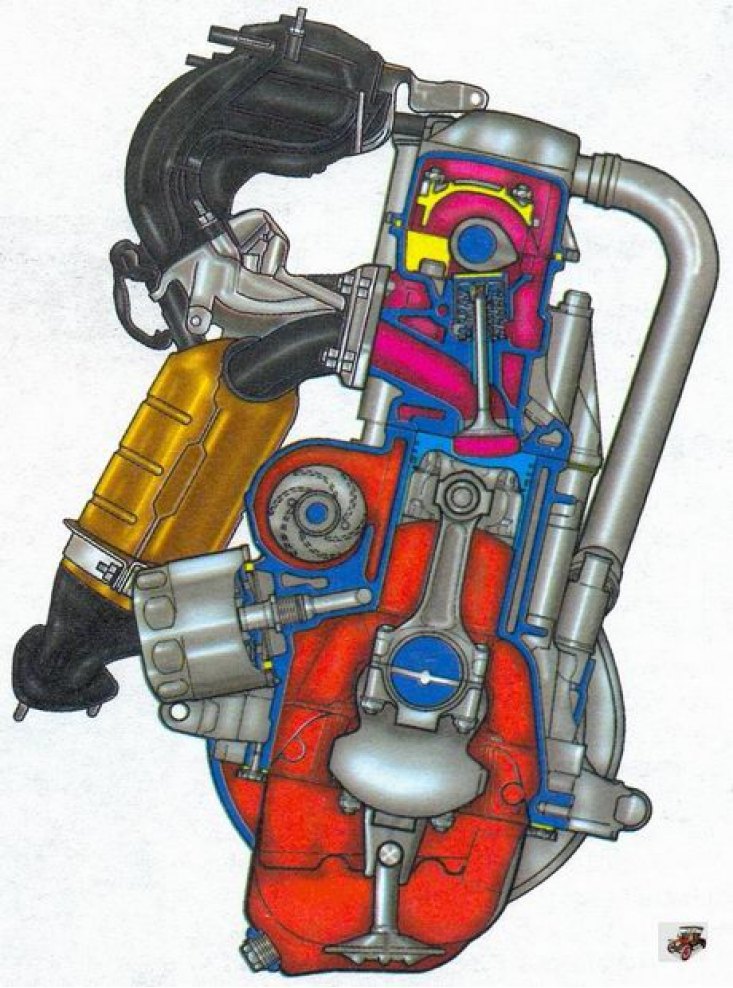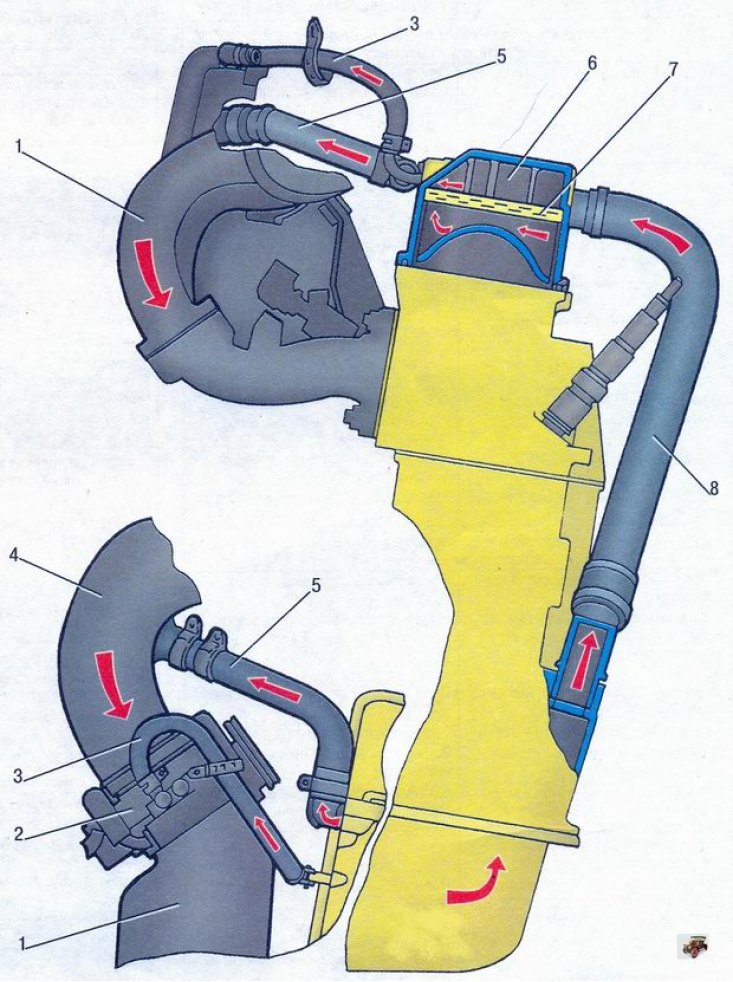Engine block cast from special high-strength cast iron, which gives the engine structure rigidity and strength.
Coolant ducts forming a cooling jacket are made along the entire height of the block, this improves the cooling of the pistons and reduces block deformation from uneven overheating. The cooling jacket is open at the top towards the head of the engine block. In the lower part of the cylinder block there are five crankshaft main bearing supports, the covers of which are attached with bolts. The supports are equipped with thin-walled steel-aluminum liners that act as crankshaft bearings. There are grooves in the middle support, into which thrust half rings are inserted, holding the crankshaft from axial movements.
Compared to the engine block mod. 2111 cylinder block mod. 21114 is 2.3 mm higher, the height from the axis of the main bearing beds to the upper plane of the block is 197.1 mm.
Crankshaft cast from special ductile iron. The main and connecting rod journals of the crankshaft are ground. To lubricate the connecting rod bearings, oil channels are drilled in the crankshaft, closed with plugs. To reduce vibration, eight counterweights are located on the crankshaft. Crank radius of the engine crankshaft mod. 21114 is 2.3 mm larger than the motor mod. 2111, due to this, the piston stroke increased from 71 to 75.6 mm. To distinguish the shafts on one of the counterweights of the crankshaft of the engine mod. 21114 molded markings «1118».
At the front end of the crankshaft, an oil pump, a camshaft drive belt pulley and an alternator drive pulley with a built-in vibration damper are installed. At the rear end of the crankshaft is a cast iron flywheel. A steel toothed rim is pressed onto the flywheel.
connecting rods steel, forged, with covers on the lower heads. Thin-walled liners are installed in the lower head of the connecting rod, and a steel-bronze bushing is pressed into the upper head.
Pistons cast from aluminum alloy. Three rings are installed on each of them: two upper compression rings and a lower oil scraper. On the bottoms of the pistons there is a recess for the combustion chamber and two recesses for the valves.
oil sump steel, stamped, bolted to the cylinder block from below.
Block head, mounted on top of the cylinder block, is cast from an aluminum alloy. In the lower part of the cylinder head, channels are cast through which the liquid circulates, which cools the combustion chambers. A camshaft is installed at the top of the cylinder head. The camshaft rotates in bearings made in the upper part of the block head, and in two bearing housings fixed with nuts on studs screwed into the cylinder head.
Combustion chamber in the engine block head mod. 21114 has become larger compared to the engine mod. 2111: its length increased from 79 to 81 mm, and its width from 48 to 50 mm. To distinguish the heads of the block next to the threaded hole for the spark plug of the 1st cylinder of the engine head mod. 21114 there is a tide with a number «1118».
Camshaft car cast iron. To reduce wear, the working surfaces of the cams and the surface under the stuffing box are heat-treated - bleached.
Due to the fact that on the engine mod. 21114 phased fuel injection is used, a phase sensor is installed in the engine management system. To ensure its operation, a marker pin is pressed into the rear camshaft trunnion.
The camshaft lobes actuate the valves through the tappets. In the upper part of the pushers, steel shims are installed, the selection of which regulates the clearances in the valve drive.
The engine has two valves per cylinder: one intake valve and one exhaust valve.
Guide bushings and valve seats are pressed into the block head. The guide bushings are also equipped with retaining rings to keep them from falling out. Oil scraper caps are installed on the guide bushings, which reduce the ingress of oil into the cylinders.
Each valve has two springs. The camshaft is driven by a rubber toothed belt from the crankshaft. Pulleys of camshafts of engines mod. 21114 and 2111 differ: mark for setting the valve timing on the engine pulley mod. 2111 is located in the middle of the cavity between the teeth, and the engine mod. 21114 is shifted by 2°.
Engine lubrication system on the car combined: spraying and under pressure. Under pressure, the main and connecting rod bearings and camshaft bearings are lubricated. The engine lubrication system consists of an oil sump, a gear oil pump with an oil receiver, a full-flow oil filter, an oil pressure sensor and oil channels.
Engine cooling system consists of a cooling jacket, a radiator with an electric fan, a centrifugal water pump, a thermostat, an expansion tank and hoses.
Engine power system includes an electric fuel pump installed in the fuel tank, a throttle assembly, a fuel fine filter, a fuel pressure regulator, injectors and fuel hoses. Differences in the elements of the power supply system of the engine mod. 21114 from engine mod. 2111:
- the tubular fuel rail without fuel return is made of stainless steel instead of aluminum;
- reduced size fuel injectors are not interchangeable with the previous injectors;
- redesigned fuel pressure regulator installed in the fuel pump module instead of on the fuel rail;
- there is no hole in the throttle assembly connecting the air supply hose to the intake module bypassing the throttle valve. Throttle assembly flange configuration has been changed.
The engine power system functionally includes vapor recovery system with carbon adsorber (see «Replacement of components of the fuel vapor recovery system»), preventing fuel vapors from escaping into the atmosphere.
Ignition system consists of an ignition coil mounted on a special bracket on the cylinder block, spark plugs and high voltage wires. Controls the ignition coil electronic control unit (ECU) engine. Installation of an ignition coil controlled by the ECU instead of the engine ignition module mod. 2111, improved system reliability.
Engine ventilation system closed, with removal of crankcase gases through the grid 7 (pic. 4.3) oil separator installed in the cover 6 of the cylinder head into the intake pipe. Further crankcase gases are sent to the engine cylinders, where they burn out. When the engine is idling, crankcase gases enter through hose 3 of the small circuit through a calibrated hole (jet) in the throttle body. In this mode, a high vacuum is created in the intake pipe and crankcase gases are effectively sucked into the throttle space. The jet limits the amount of exhaust gases so that the engine is not disturbed at idle. When the engine is running under load, when the throttle is partially or fully open, the main volume of gases passes through the hose 5 of the large circuit into the air supply sleeve 4 in front of the throttle assembly and then into the intake pipe and combustion chambers.

Pic. 4.1. Longitudinal section of the engine

Pic. 4.2. Cross section of the engine

Pic. 4.3. Diagram of the crankcase ventilation system: 1 - intake module; 2 - throttle assembly; 3 - hose of the small circuit of the ventilation system; 4 - air supply sleeve; 5 - hose of the large circuit of the ventilation system; 6 - cylinder head cover; 7 - oil separator mesh; 8 - exhaust hose
